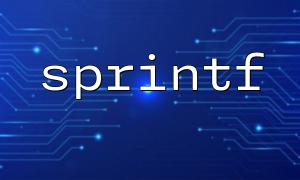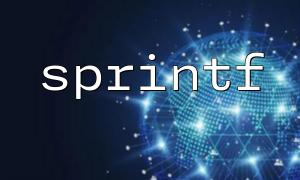In PHP, the sprintf function is used to format strings, which allows the specified format to be applied to variables and returns the formatted string. In actual development, we often use the sprintf function to format the output, including numbers, strings, booleans and null values. However, different types of values are handled differently in sprintf , especially boolean and null values.
This article will explore how the sprintf function handles boolean and null values and analyzes the specific situation.
The basic syntax of the sprintf function is as follows:
sprintf(string $format, mixed ...$values): string
where $format is a formatted string that defines the format of the output. $values is one or more values passed to a format string. Common formatting symbols include:
%s : represents a string
%d : represents a signed decimal integer
%f : represents a floating point number
%b : represents a binary number
In PHP, the boolean can be true or false , but how will it handle it when formatting the boolean with sprintf ?
Boolean value true
When the boolean is true , sprintf converts it to the string "1" . This is because in PHP, the corresponding value of true is 1 .
Boolean value false
When the boolean value is false , sprintf converts it to the string "0" because in PHP, the corresponding value of false is 0 .
$trueValue = true;
$falseValue = false;
echo sprintf("Boolean value true Formatted as:%s\n", $trueValue); // Output: Boolean value true Formatted as:1
echo sprintf("Boolean value false Formatted as:%s\n", $falseValue); // Output: Boolean value false Formatted as:0
In the above code, true and false are formatted to "1" and "0" , which is consistent with the performance of boolean values in PHP.
In PHP, null is a special type used to represent a variable without a value. When null is formatted using sprintf , null is converted to a string "" (empty string).
$nullValue = null;
echo sprintf("null Formatted as:%s\n", $nullValue); // Output: null Formatted as:
As shown above, the null value is converted to an empty string in sprintf and there is no output.
When formatting boolean and null values, we need to pay attention to the following points:
The boolean true will be converted to "1" and false will be converted to "0" , which may have different effects in some scenarios where the boolean value is required.
null will be formatted as an empty string "" . If you want to display a specific value after formatting, you can make conditional judgments before formatting.
$nullValue = null;
$formattedNull = sprintf("null value: %s", $nullValue === null ? '无value' : $nullValue);
echo $formattedNull; // Output: null value: 无value
In this example, we replace the null value with a custom string 'no value' by conditional judgment, so that we can ensure that null does not appear as an empty string when formatting the string.
Through the above analysis, we can see:
Boolean values are converted to "1" ( true ) or "0" ( false ) in sprintf .
The null value in sprintf will be converted to an empty string "" .
Therefore, it is very important to understand this behavior of sprintf , especially when it comes to boolean and null values, we need to clarify how they are processed, so as to avoid the formatted output not meeting expectations.
Related Tags:
null













